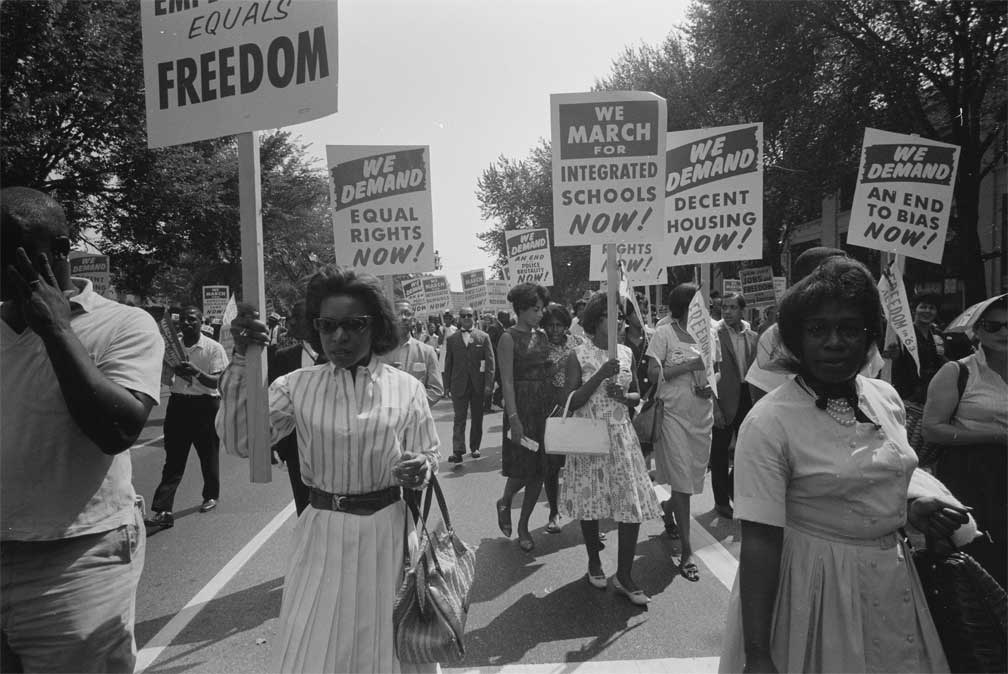1963 March on Washington

|
On August 28, 1963, a major event known as the March on Washington for Jobs and Freedom took place , it became the largest non-violent demonstration ever held in the nation’s capital to advocate for civil rights legislation. Approximately 200,000 people from diverse backgrounds converged on the National Mall, demonstrating their support for equality and justice for African Americans.
The march began in the morning as participants gathered at the Washington Monument. By noon, the crowd had swelled significantly, filling the area and creating a sea of humanity united in their demand for civil rights. The atmosphere was one of peaceful determination, with people carrying signs, singing freedom songs, and chanting slogans that called for equal rights and an end to racial segregation.
Participants in the march included individuals from all walks of life, including labor unions, religious groups, civil rights organizations, and student activists. Notable figures present included labor leader A. Philip Randolph, who was one of the main organizers of the event, along with civil rights leaders such as Bayard Rustin, John Lewis, and Dr. Martin Luther King Jr.
The marchers proceeded from the Washington Monument to the Lincoln Memorial, where a series of speeches, performances, and prayers took place. The program was carefully planned to maintain the focus on the goals of the demonstration: the passage of meaningful civil rights legislation, the end of racial segregation, and the protection of voting rights for African Americans.
Throughout the afternoon, various speakers took to the podium to address the crowd. They spoke about the ongoing struggles faced by African Americans in their fight for equality and justice. Performances by notable artists such as Mahalia Jackson and Joan Baez added to the inspirational atmosphere of the day.
The highlight of the event was the speech delivered by Dr. Martin Luther King Jr. Standing on the steps of the Lincoln Memorial, King addressed the massive crowd with a speech that would become one of the most iconic and defining moments of the Civil Rights Movement.
Dr. King’s speech, famously known as the “I Have a Dream” speech, resonated deeply with the audience and with people across the nation. He began by referencing the Emancipation Proclamation and the unfulfilled promise of freedom for African Americans. King then vividly described his dream of a future where racial injustice and discrimination would be eradicated, and where all people would be judged by the content of their character rather than the color of their skin.
King stated, “I have a dream that one day this nation will rise up and live out the true meaning of its creed: we hold these truths to be self-evident; that all men are created equal.” His words were met with thunderous applause and have since become synonymous with the fight for civil rights in the United States.
The event concluded peacefully, with participants dispersing in an orderly manner, leaving behind a powerful message of unity and determination. The March on Washington for Jobs and Freedom not only succeeded in drawing national attention to the urgent need for civil rights legislation but also demonstrated the power of non-violent protest.
After the successful march Dr. Martin Luther King Jr., met with President John F. Kennedy at the White House. This meeting was a significant follow-up to the historic demonstration. The meeting with President Kennedy took place in the late afternoon, immediately following the rally. The group of leaders, often referred to as the “Big Six,” included Dr. Martin Luther King Jr., A. Philip Randolph, Roy Wilkins of the NAACP, Whitney Young of the National Urban League, John Lewis of the Student Nonviolent Coordinating Committee (SNCC), and James Farmer of the Congress of Racial Equality (CORE). They were accompanied by other prominent civil rights figures and advisors.
During the meeting, the leaders reiterated the demands and goals presented during the march. These included the passage of comprehensive civil rights legislation, the end of racial segregation in public schools and facilities, protection of voting rights, and measures to address economic disparities faced by African Americans, such as fair employment practices and a higher minimum wage.
President Kennedy, who had expressed support for civil rights but faced significant opposition from southern legislators and others resistant to change, listened attentively to the leaders’ concerns. The president acknowledged the significance of the march and the peaceful manner in which it was conducted, which had a profound impact on public opinion and demonstrated the widespread support for civil rights reforms.
Kennedy expressed his administration’s commitment to advancing civil rights legislation. He recognized the challenges ahead but emphasized his determination to work towards the passage of the Civil Rights Act. The leaders and President Kennedy discussed strategies to garner broader support for the legislation in Congress, including efforts to reach out to moderate lawmakers and mobilize public opinion.
The meeting also highlighted the solidarity and unity within the civil rights movement, with leaders from various organizations and backgrounds presenting a cohesive front in their advocacy for justice and equality. The leaders’ ability to present a united message to the president reinforced the movement’s strength and resolve.
Following the meeting, the leaders expressed cautious optimism. They recognized the significance of the president’s support but also understood the considerable challenges that lay ahead. The commitment from the Kennedy administration provided a crucial boost to their efforts, but the struggle for civil rights would require continued advocacy, grassroots mobilization, and strategic political engagement.
The discussions at the White House further solidified the relationship between the civil rights movement and the federal government. While the leaders continued to push for immediate and substantive changes, the meeting with President Kennedy represented a step forward in their ongoing efforts to achieve legislative and social reforms.
 >
>